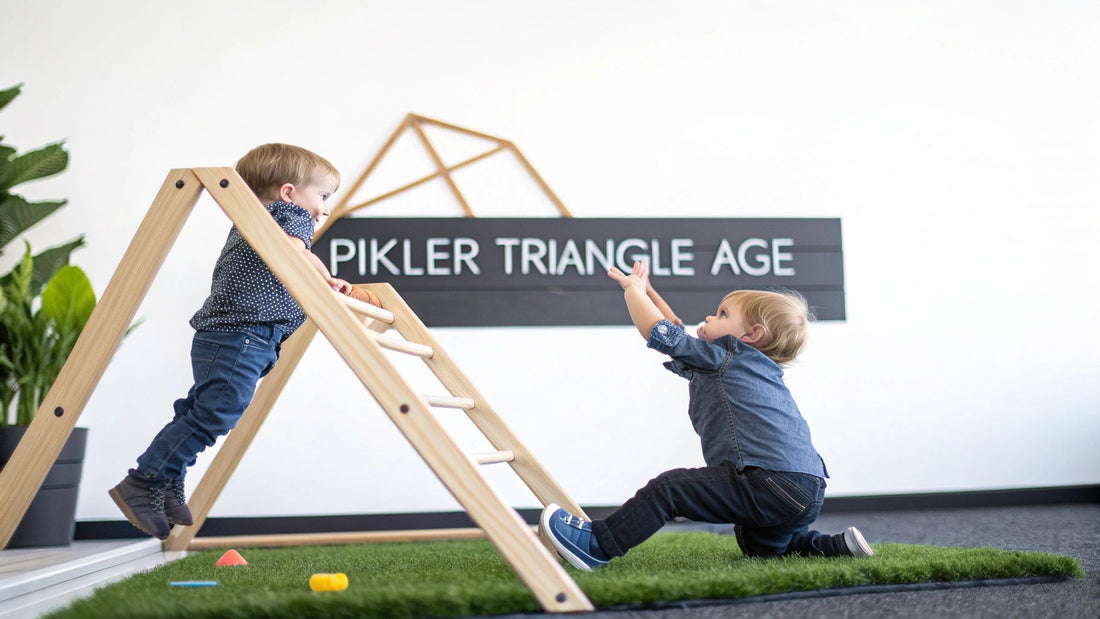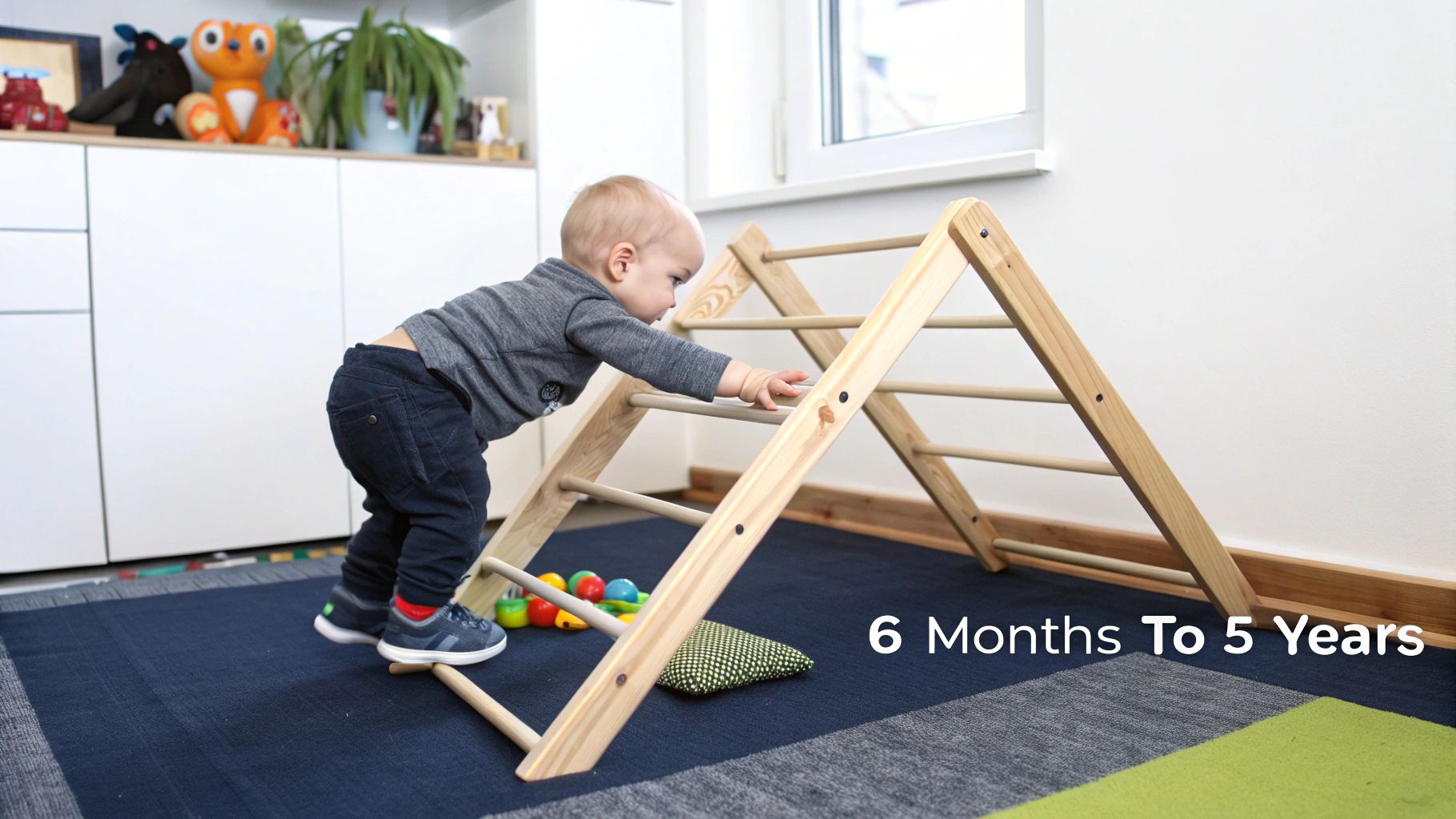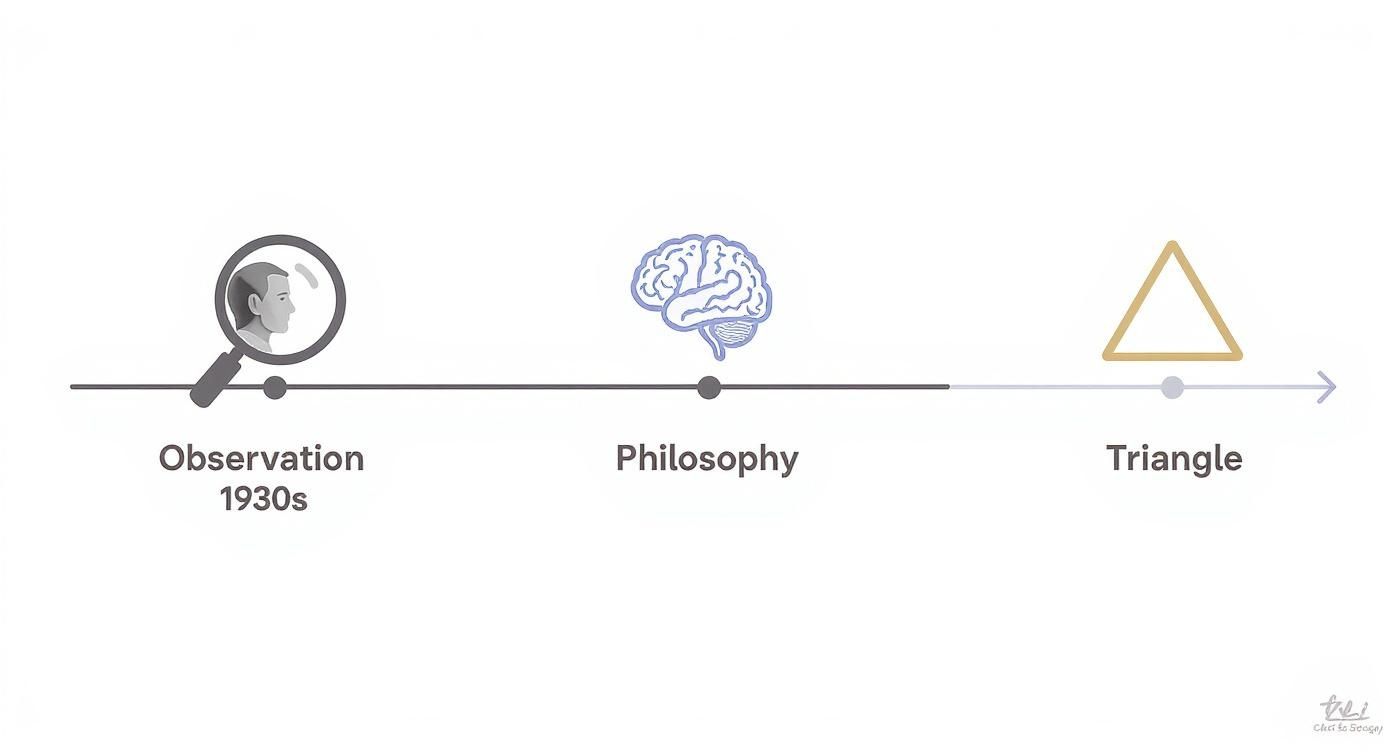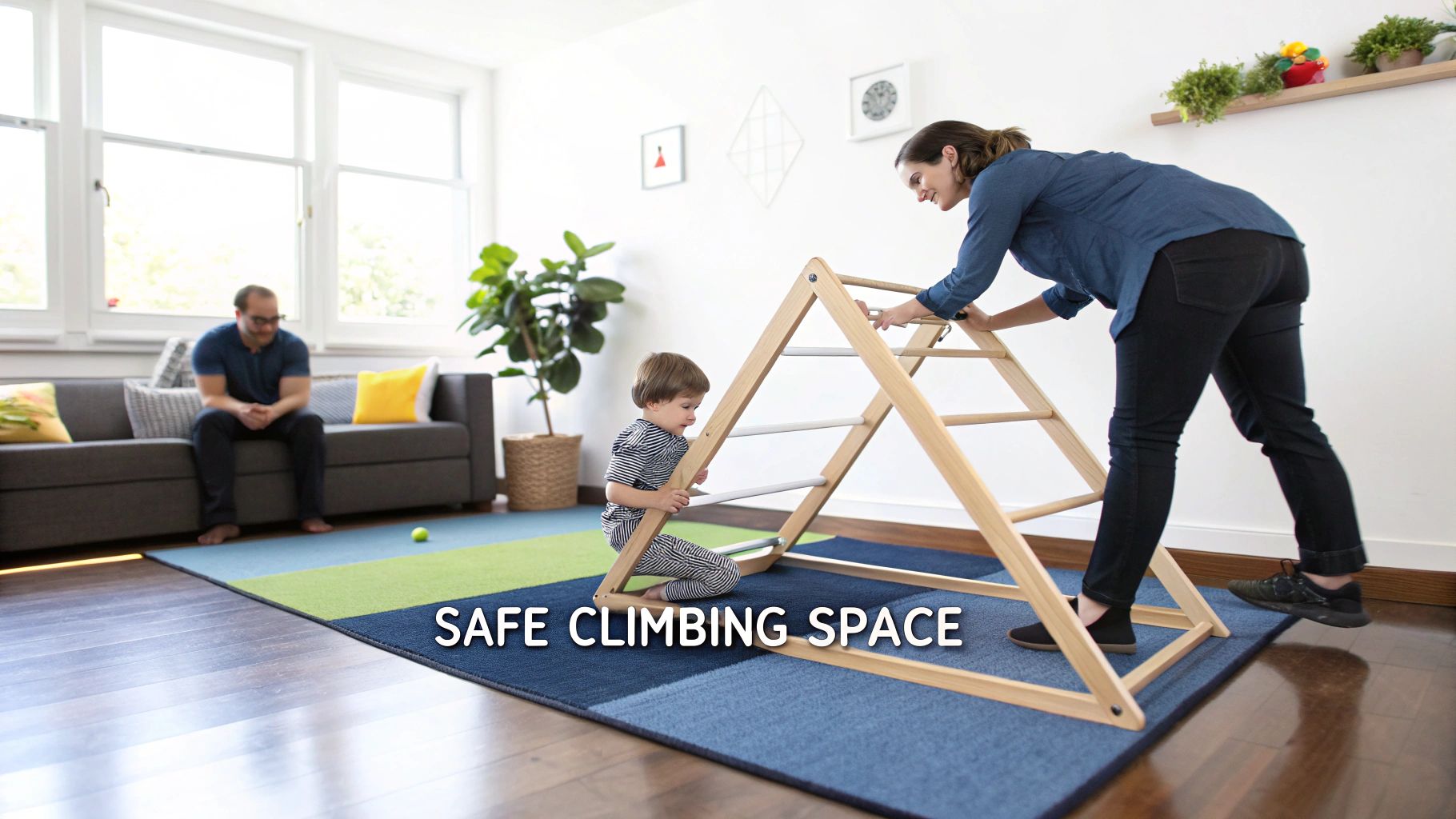
Pikler Triangle Age Guide for Modern Parents
Share
One of the best things about the Pikler triangle is just how long your child will use it. It's an investment that truly pays off over the years. We typically see kids start exploring it around 6 months old and stay fascinated with it all the way up to age 5 or even 6.
Why the Pikler Triangle Grows With Your Child
Unlike so many baby and toddler items that have a short shelf life, the Pikler triangle is a dynamic tool that meets your child right where they are developmentally. It offers new challenges and fresh ways to play as they get bigger and more confident.
This adaptability is its real magic, ensuring it stays a favorite in the playroom for years, not just months.

Developmental Milestones and The Triangle
The journey usually begins around 6 months, right when your baby starts trying to pull themselves up. The triangle’s rungs are the perfect height for them to grab onto, practice standing, and eventually start cruising. It’s a fantastic way to build that crucial leg strength and coordination.
From there, it just gets more interesting. We've put together a quick guide to show how children's interactions with the triangle evolve over time.
How Children Use a Pikler Triangle by Age
| Age Group | Typical Interaction and Skills Developed |
|---|---|
| 6-12 Months | Pulling up to a stand, cruising along the rungs. Building core strength and balance. |
| 1-2 Years | Tentative climbing up a few rungs and back down. Developing gross motor skills and body awareness. |
| 2-3 Years | Confidently climbing to the top and over. Honing motor planning and problem-solving. |
| 3-5+ Years | Using it as a base for imaginative play—a fort, a mountain, a ship. Enhancing creativity and physical confidence. |
As you can see, the triangle seamlessly transitions from a simple climbing frame to a launchpad for imagination. This natural progression makes it one of the most versatile tools for encouraging independent play. It works perfectly alongside other toddler gross motor activities to support your child’s physical development at home.
Understanding the Philosophy Behind the Triangle
The Pikler triangle is so much more than a simple climbing frame—it's a physical nod to a deep respect for a child's natural developmental journey. The whole concept is rooted in the incredible work of Dr. Emmi Pikler, a pioneering Hungarian pediatrician from the mid-20th century. Her entire philosophy was built on one powerful idea: trusting children to learn and grow at their own pace.
Dr. Pikler noticed that when children were given the freedom to move without constant adult intervention, they developed confidence and physical skills all on their own. Back in the 1930s, she observed that these kids actually had fewer injuries than those who were always being restricted. This led her to create a simple yet brilliant tool—a wooden climbing structure that invites safe, self-directed exploration.
Trusting the Child’s Inner Wisdom
The core idea is beautifully simple: a child knows exactly what their body is ready for. The triangle isn't designed for a parent to place their child on the top. Instead, it’s an open invitation for a child to explore—to pull themselves up, to cruise along the base, to take that first brave step onto a rung, and eventually, to climb right over the top when they feel ready.
“The Pikler approach is about allowing the child to move freely and develop at his or her own pace. The triangle facilitates this by offering challenges that the child can choose to engage with when they are developmentally ready.”
This focus on self-initiated movement doesn't just build gross motor skills. It fosters independence, self-confidence, and a powerful, innate understanding of their own physical limits. It’s a fantastic way to support a child's journey toward autonomy.
The philosophy behind the Pikler triangle, with its emphasis on self-directed play and motor development, aligns perfectly with Montessori principles, which you can see in a wide range of Montessori toys for toddlers.
Your Stage-by-Stage Guide to Using the Pikler Triangle
Watching a child interact with a Pikler triangle is a beautiful thing. It’s a journey that perfectly mirrors their own growth, from a wobbly baby to a confident preschooler. When people ask about the right Pikler triangle age, the answer is that it spans the whole of early childhood, adapting to their needs every step of the way.
The timeline below gives you a glimpse into how Dr. Emmi Pikler's groundbreaking observations in the 1930s evolved into the philosophy and, eventually, the triangle we know and love today.

This just goes to show that the triangle wasn't some random invention. It was born directly from watching how children naturally learn to move, creating a tool designed to honor their individual pace.
The Explorer Stage: 6 to 12 Months
This first phase is all about discovery and building that core strength. Around 6 months old, you’ll notice your baby trying to pull themselves up on everything, and the triangle’s rungs offer the perfect, stable support to do just that.
Think of the triangle as your baby’s first personal gym. During this stage, they'll use it to:
- Practice pulling to a stand, which is a full-body workout for their legs, core, and arms.
- Cruise along the base, taking those first wobbly but triumphant sideways steps.
- Explore the different textures and angles with their hands and mouths, boosting sensory awareness.
This is a really critical window for building the physical confidence that comes right before walking. The triangle gives them a safe, accessible challenge that lets them test their budding skills completely on their own terms.
The Climber Stage: 1 to 3 Years
Once your little one is walking confidently, the triangle’s role shifts. It’s no longer just a support structure—it's now a vertical challenge. This is when the real climbing begins, and it’s an absolute joy to witness their determination and skill grow.
A toddler in the climber stage learns to navigate the rungs with more and more coordination. They might start by cautiously placing a single foot on the bottom rung, and over weeks and months, they build the strength and motor planning needed to go higher. It’s here that they develop a really sharp sense of body awareness and start to understand their own limits.
The goal isn't to race to the top. It's all about the process—learning how to shift their weight, coordinate their arms and legs, and even assess risk. Every single climb, no matter how small, is a huge win in problem-solving.
The Imaginative Stage: 3 to 5 Years
As kids hit the preschool years, their physical mastery of the triangle starts to blend with a huge burst of creativity. The structure literally transforms from a piece of climbing equipment into a launchpad for imaginative play.
At this Pikler triangle age, it stops being just a climber and becomes anything they can dream up:
- A cozy fort or a secret cave when you drape a blanket over it.
- A treacherous mountain they have to conquer on a grand expedition.
- A pirate ship sailing across the living room sea.
This is the stage that really highlights the triangle's long-term value. It becomes a prop for complex, collaborative play and storytelling, proving that its benefits go far beyond gross motor skills and deep into the world of creativity and social development.
How to Create a Safe Climbing Environment

The heart of the Pikler philosophy is trusting your child to explore their own physical limits. That trust really starts with us, the parents, by creating a truly secure play space. When they feel safe, they’re empowered to climb with confidence, knowing there’s a soft place to land if they take a little tumble.
The foundation of a safe setup is, quite literally, the foundation. Always set up your Pikler triangle on a surface that’s soft but still firm. A dense play mat or a low-pile rug on top of carpet strikes that perfect balance of cushion and stability, which keeps the triangle from sliding around. You can learn more about picking the best foam play mat to create the ideal base for their climbing adventures.
Location and Supervision
Where you put the triangle is just as important as what you put it on. Make sure there’s plenty of open space on all sides, well away from hard furniture, sharp corners, or a pile of other toys. A good rule of thumb is to create at least a three-foot buffer zone. This gives your little one enough room to get on, off, and all around it without any risks.
Supervision is a must, but the Pikler approach encourages a very specific kind of oversight: being present without constantly interfering. It’s about staying close enough to step in if absolutely necessary, but also giving your child the space to figure things out on their own.
Your job is to be a calm, reassuring presence—not a director of their play. This is how they build real self-confidence and start to understand their own physical boundaries.
This hands-off yet attentive method is so important. It lets them experience minor slips and self-corrections, which are actually powerful learning moments.
Daily Safety Checks
Before every play session, it's a great habit to do a quick inspection. This simple routine takes less than a minute and ensures the climber is a safe place for every Pikler triangle age group.
- Check for Stability: Give the triangle a gentle shake. You want to make sure it’s locked firmly in place and not wobbly at all.
- Inspect the Rungs: Run your hands over each rung to feel for any splinters, cracks, or loose parts.
- Clear the Area: Just take a quick look around to make sure the play area is still free of any new obstacles or hazards that might have appeared.
By setting up a thoughtful environment, you’re giving your child the freedom they need to explore, learn, and grow with their Pikler triangle.
Choosing the Right Pikler Triangle for Your Family
https://www.youtube.com/embed/k_BbAiPQYAs
Picking out the perfect Pikler triangle can feel like a big decision, but it gets a lot easier when you know what to look for. The goal is to find a climber that’s not just fun, but also safe, durable, and a great match for your child’s stage of development, no matter their specific Pikler triangle age.
What to Look For in a Quality Climber
First things first: material and construction are everything. You want a triangle built from a high-quality, solid wood like birch or beech. These woods have the strength and stability to handle years of enthusiastic climbing. Just as important are the finishes—make sure they are non-toxic and child-safe, because you can bet that at some point, your little one is going to explore it with their mouth.
Pay close attention to the rungs. The spacing is a critical safety feature. They need to be close enough for little feet to find their footing, but not so far apart that a child's head could get stuck. The diameter of the rungs matters, too. They should be just right for tiny hands to get a firm, confident grip.
Getting the Size and Accessories Right
Pikler triangles come in all shapes and sizes. You'll find smaller models perfect for babies just starting to pull up, and larger, foldable versions that are great for saving space. Think about your play area and your child's current size, but also try to think ahead. A slightly larger triangle might seem a bit big right now, but it will give your child much more room to grow.
Lots of parents wonder if they should get accessories like ramps, slides, or climbing arches. These are fantastic additions that open up a whole new world of play, especially for toddlers and preschoolers who are craving more complex physical challenges. A complete Pikler triangle set can give you a good idea of how all the pieces can work together to create an incredible mini-playground.
The best triangle is one that safely meets your child's current abilities while offering room to grow. Prioritize sturdy construction and safe materials over bells and whistles.
To make things a bit simpler, I’ve put together a quick comparison of the most common features you'll come across when shopping.
Pikler Triangle Feature Comparison
This table breaks down the key features to help you zero in on what's most important for your family's needs.
| Feature | What to Look For | Why It Matters |
|---|---|---|
| Wood Type | Solid hardwoods like Baltic birch or beech. | Provides superior strength, stability, and durability for years of safe play. |
| Finishes | Water-based, non-toxic lacquers and paints. | Ensures safety for children who may chew on the rungs. |
| Size | Standard or foldable options, varying heights. | Choose based on your available space and desired longevity of use. |
| Accessories | Reversible ramps (slide/climber), arches. | Extends imaginative play and offers new physical challenges as skills develop. |
Ultimately, a well-chosen Pikler triangle isn't just a toy; it's an investment in your child's physical confidence and creative exploration. Keeping these key features in mind will help you find the one that will be loved for years.
Of course, it’s completely normal to have a few questions swirling around, even when you see all the good a Pikler triangle can do. Let's walk through some of the most common things parents ask so you can feel totally confident about bringing this fantastic tool into your home.
Is a Pikler Triangle Really Worth the Investment?
Without a doubt. While it might seem like a bigger upfront cost than your average toy, the real value is in how long it lasts. This isn't something your child will use for a few months and then forget about. The Pikler triangle is right there with them from the time they’re pulling up at 6 months all the way through creative make-believe games at 5 years old and beyond.
Think of it this way: it's a baby gym, a toddler climbing frame, and a preschooler's secret fort all rolled into one. When you tally up the years of active, skill-building play it offers, the investment makes perfect sense for every Pikler triangle age.
What If My Child Isn't Interested at First?
Don't panic—this happens more often than you'd think. Kids have their own unique timetables for exploring new things. The best thing you can do is simply make it available in their play area. Let it be a standing invitation, with zero pressure to perform.
Your role is to create the opportunity, not to direct the play. A child's internal drive will lead them to explore the triangle when they are developmentally ready and feel curious enough to try.
You can always gently spark their interest by modeling fun ways to use it. Drape a blanket over it to make a cozy tunnel or place a beloved stuffed animal on one of the lower rungs. These playful, gentle nudges almost always work better than trying to coax them onto it.
Can We Use the Pikler Triangle Outdoors?
That really comes down to the finish on the wood. Most Pikler triangles are built for indoor life, since things like moisture, harsh sunlight, and big temperature swings can wear down the wood over time.
That said, bringing it out on a beautiful, dry day for a supervised play session is totally fine! Just make sure you:
- Set it up on a flat, dry surface like your patio or a thick blanket on the grass.
- Give it a good wipe-down afterward to get rid of any dirt or dampness.
- Always bring it back inside for storage to keep it protected from the weather.
At Ocodile, we design beautiful, child-safe furniture that grows with your family. Explore our collection of thoughtfully crafted pieces designed to foster independence and make everyday moments special. Discover the perfect additions for your home at Ocodile.








